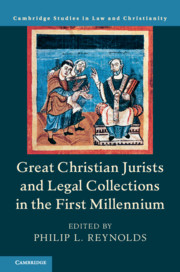Book contents
- Great Christian Jurists and Legal Collections in the First Millennium
- Law and Christianity
- Great Christian Jurists and Legal Collections in the First Millennium
- Copyright page
- Contents
- Contributors
- Preface and Acknowledgments
- Abbreviations
- Part I
- Part II
- 10 Lactantius
- 11 Ambrosiaster
- 12 Augustine of Hippo
- 13 Leo the Great
- 14 Gelasius I
- 15 Dionysius Exiguus
- 16 Benedict’s Rule
- 17 Gregory the Great
- 18 Isidore of Seville
- 19 Pseudo-Isidorus Mercator
- 20 Jonas of Orléans
- 21 Hincmar of Reims
- 22 Regino of Prüm
- 23 Burchard of Worms
- 24 New Horizons in Church Law
- Index
- References
15 - Dionysius Exiguus
from Part II
Published online by Cambridge University Press: 21 June 2019
- Great Christian Jurists and Legal Collections in the First Millennium
- Law and Christianity
- Great Christian Jurists and Legal Collections in the First Millennium
- Copyright page
- Contents
- Contributors
- Preface and Acknowledgments
- Abbreviations
- Part I
- Part II
- 10 Lactantius
- 11 Ambrosiaster
- 12 Augustine of Hippo
- 13 Leo the Great
- 14 Gelasius I
- 15 Dionysius Exiguus
- 16 Benedict’s Rule
- 17 Gregory the Great
- 18 Isidore of Seville
- 19 Pseudo-Isidorus Mercator
- 20 Jonas of Orléans
- 21 Hincmar of Reims
- 22 Regino of Prüm
- 23 Burchard of Worms
- 24 New Horizons in Church Law
- Index
- References
Summary
Dionysius Exiguus (sixth century) contributed to making Greek patristic literature available in Latin. He was also the creator of the Dionysian Era (Common Era), which we still use today. His Collectio Dionysiana became a basic collection of canonical ius in the Western church during the first millennium. The Collectio Dionysiana was composed of two books: the Liber canonum, and the Liber decretalium. The Liber canonum is a collection of disciplinary decrees from church councils: mostly Eastern, but with some Western (Latin) councils. The Liber decretalium is a collection of decretal letters by the bishops of Rome (plus one imperial statute). The Collectio Dionysiana originated at a time of internal conflicts in the Church of Rome, when various factions used forgeries to claim legitimacy. The Collectio Dionysiana may have been a reaction against the use of forgeries. Dionysius attempted to make the “authentic” sources of church discipline available. The Collectio Dionysiana was later augmented in the form of the Collectio Dionysiana-Hadriana under Pope Hadrian I (eighth century) and sent to Charlemagne. This became the standard collection of canons and decretals for the Frankish Empire.
Keywords
- Type
- Chapter
- Information
- Publisher: Cambridge University PressPrint publication year: 2019

